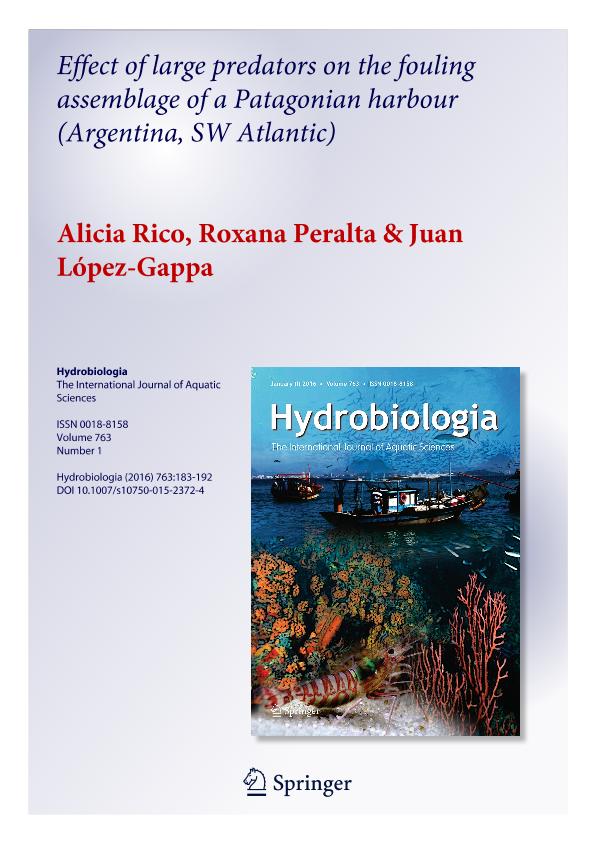Artículo
Effect of large predators on the fouling assemblage of a Patagonian harbour (Argentina, SW Atlantic)
Fecha de publicación:
06/2015
Editorial:
Springer
Revista:
Hydrobiologia
ISSN:
0018-8158
Idioma:
Inglés
Tipo de recurso:
Artículo publicado
Clasificación temática:
Resumen
Predatory control of community structure, through consumption of herbivores and subsequent positive effects on the biomass or productivity of primary producers is common in marine ecosystems. We designed an experiment to analyse the effect of large-sized predators on the development of the macrofouling assemblage of a harbour. Predation was manipulated by randomly assigning artificial substrata to three treatments: (1) exclosure cages preventing access of large predators, (2) cage controls, i.e. cages with lateral walls but without roofs, allowing predators free access, (3) uncovered panels. Substrata were submersed horizontally and upper surfaces sampled at quarterly intervals over a 1-year period. No differences in species richness were observed among treatments but diversity was lower within exclosure cages than on cage controls/uncovered panels. In sessile assemblages, structure differed between treatments: cage controls/uncovered panels were dominated by algae and associated mesoherbivores, which were scarce/absent within cages. Exposure to predators also affected the structure of mobile assemblages. The sea urchin Pseudechinus magellanicus (Philippi) occurred within exclosure cages but was never found on exposed panels. We conclude that large predators exert a significant effect on assemblage structure and diversity, indirectly promoting the development of filamentous algae and mesoherbivores by controlling the abundance of browsers.
Predatory control of community structure, through consumption of herbivores and subsequent positive effects on the biomass or productivity of primary producers is common in marine ecosystems. We designed an experiment to analyse the effect of large-sized predators on the development of the macrofouling assemblage of a harbour. Predation was manipulated by randomly assigning artificial substrata to three treatments: (1) exclosure cages preventing access of large predators, (2) cage controls, i.e. cages with lateral walls but without roofs, allowing predators free access, (3) uncovered panels. Substrata were submersed horizontally and upper surfaces sampled at quarterly intervals over a 1-year period. No differences in species richness were observed among treatments but diversity was lower within exclosure cages than on cage controls/uncovered panels. In sessile assemblages, structure differed between treatments: cage controls/uncovered panels were dominated by algae and associated mesoherbivores, which were scarce/absent within cages. Exposure to predators also affected the structure of mobile assemblages. The sea urchin Pseudechinus magellanicus (Philippi) occurred within exclosure cages but was never found on exposed panels. We conclude that large predators exert a significant effect on assemblage structure and diversity, indirectly promoting the development of filamentous algae and mesoherbivores by controlling the abundance of browsers.
Palabras clave:
Macrofouling
,
Harbour
,
Predator Exclusion Experiment
,
Patagonia
Archivos asociados
Licencia
Identificadores
Colecciones
Articulos(MACNBR)
Articulos de MUSEO ARG.DE CS.NAT "BERNARDINO RIVADAVIA"
Articulos de MUSEO ARG.DE CS.NAT "BERNARDINO RIVADAVIA"
Citación
Rico, Alicia E.; Peralta, Roxana Beatriz; López Gappa, Juan José; Effect of large predators on the fouling assemblage of a Patagonian harbour (Argentina, SW Atlantic); Springer; Hydrobiologia; 763; 1; 6-2015; 183-192
Compartir
Altmétricas




